╔
Appunti sul futuro del turismo nella città di Catania
Una città affacciata sul mare, uno spazio urbano denso e stratificato ai piedi del vulcano più alto d’Europa, innumerevoli attrattori turistici a base culturale che rendono la città dell’elefante un luogo potenzialmente molto turistico. Eppure Catania galleggia ormai da diversi anni fra malinconici ricordi della Milano del sud e una realtà che non le restituisce la giusta collocazione sul mercato turistico.
In questa barcollante e incerta ricerca di un posizionamento, la città di Catania procede in modo intermittente, affidandosi di volta in volta agli attrattori stars di cui dispone, ossia l’Etna, il patrimonio culturale, il food, senza mai però intraprendere un percorso di valorizzazione sistemica e trascurando il potenziale turistico proveniente dal suo essere città di mare. Il legame, evidentemente debole, con la parte marina della città è stato determinato anche dallo sviluppo dell’area urbana moderna che ha portato ad un allargamento del fronte mare e ad una espansione verso l’entroterra, coinvolgendo le zone collinari circostanti. Di conseguenza, il vecchio schema cartografico che associava la città al mare e al porto non riflette più la realtà attuale, a fronte di un cambiamento nell’assetto urbano nel tempo, con un maggiore sviluppo anche delle altre infrastrutture di trasporto terrestre (Di Bella, 2011). Gli sforzi per dare nuovo impulso, trasformando il porto, vissuto negli ultimi decenni quasi ai margini della città, in una risorsa per il territorio, ha rappresentato una delle principali questioni politiche legate allo sviluppo della città, ancora oggi molto dibattute.
A city overlooking the sea, a dense and stratified urban space at the foot of the highest volcano in Europe, many culturally based tourist attractors that make the “elephant city” a potentially very touristy place. Yet Catania has been floating for several years between memories of southern Milan and a reality that does not give it the right place on the tourist market.
In this search for a market positioning, the city of Catania proceeds intermittently, using the star attractors at its disposal: Etna, cultural heritage, food, without ever undertaking a path of systemic valorisation and neglecting the potential tourist coming from its being a seaside city. The evidently weak link with the seaside part of the city was also determined by the development of the modern urban area which led to a widening of the sea front and an expansion towards the hinterland, involving the surrounding hilly areas. Consequently, the old cartographic scheme that associated the city with the sea and the port no longer reflects the current reality, in the face of a change in the urban structure over time, with a greater development of other land transport infrastructures (Di Bella, 2011). The efforts to give new impetus, transforming the port, which in recent decades has lived almost on the edge of the city, into a resource for the territory, has represented one of the main political issues linked to the development of the city, still much debated today.
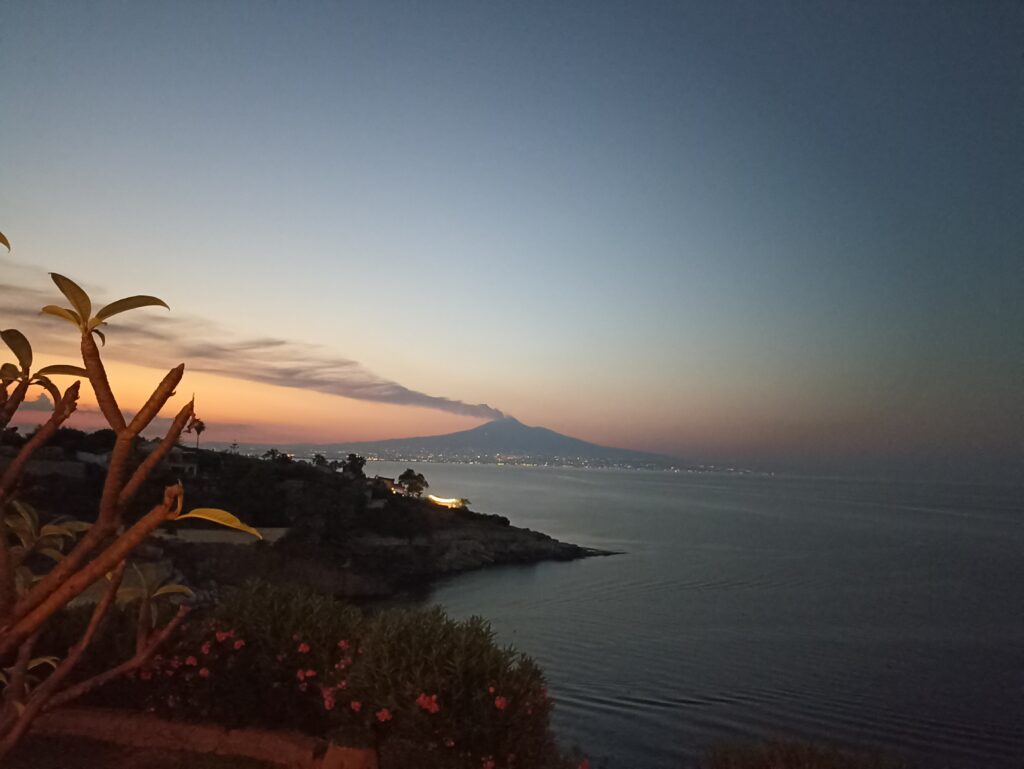
Panorama della costa al tramonto e veduta dell’Etna durante un’eruzione. (Fotografia: Elena Cocuzza).
Panorama of the coast at sunset and view of Etna during an eruption. (Photo: Elena Cocuzza).
La Blue Economy e il turismo locale
The Blue Economy and Local Tourism
Per superare questa impasse, Catania dovrebbe dunque proiettare il suo futuro sfruttando pienamente le opportunità della Blue Economy, con una progettazione del suo sviluppo realizzata in una ottica di filiere integrate ed interdipendenti, anche considerando che molte delle imprese coinvolte nella filiera del mare sono impegnate nella produzione di servizi di alloggio e ristorazione, tradizionalmente core del settore dell’ospitalità.
Per dare una dimensione della parte turistica della Blue Economy locale, facciamo riferimento ai rapporti dell’Istituto Tagliacarne, realizzati nel corso degli ultimi anni, che riportano per Catania un contributo dei servizi di alloggio e ristorazione, in termini di valore aggiunto, di circa il 25 per cento e un valore altrettanto simile per quanto riguarda il lavoro. Le dimensioni locali dell’economia del mare sono considerevoli: nel 2022 nella città di Catania si concentra più della metà delle imprese registrate dell’Economia del Mare a livello provinciale, ossia il 53% del valore complessivo provinciale e quasi il 10% del totale regionale. Nella città le imprese registrate nella Blue Economy hanno una incidenza del 7.7% sul totale delle imprese del comune. Questo articolato complesso di attività produttive e di servizi dovrebbe essere in un rapporto maggiormente sistemico con l’industria del turismo, ma in realtà ciò non sembra avvenire a causa della già citata marginalità dell’area marina rispetto alla città e della sostanziale assenza di governance di destinazione.
To overcome these difficulties, Catania should exploit the opportunities of the blue economy, by planning its development with integrated and interdependent supply chains, also considering that many of the companies involved in the sea supply chain are engaged in the production of accommodation and catering services, traditionally core of the hospitality sector.
To give a dimension of the tourist part of the local Blue Economy, we refer to the studies of the Tagliacarne Institute, carried out over the last few years, which report for Catania a contribution of accommodation and catering services, in terms of added value, of approximately 25 percent and an equally similar value for work. The local dimensions of the maritime economy are considerable: in 2022, more than half of the registered Sea Economy businesses at provincial level are concentrated in the city of Catania, i.e. 53% of the overall provincial value and almost 10% of the regional total. In the city, the companies registered in the Blue Economy have an impact of 7.7% on the total number of companies in the municipality. These productive and service activities should be in a more systemic relationship with the tourism industry, but this does not seem to happen due to the aforementioned marginality of the marine area compared to the city and the substantial absence of destination governance.
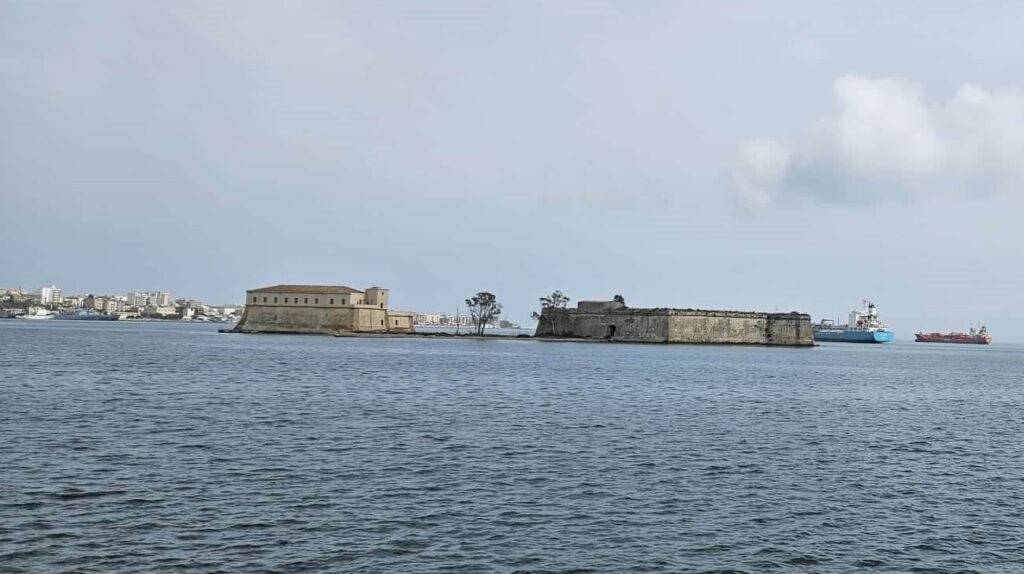
Veduta dal terminal container dei forti di Garcia e di Vittoria all’interno del Porto di Augusta. (Fotografia: Elena Cocuzza).
View from the container terminal of the Garcia and Vittoria forts inside the Port of Augusta. (Photo: Elena Cocuzza).
Catania nel mercato turistico
Catania in the Tourist Market
In parte Catania rispecchia le diverse debolezze del mercato turistico meridionale. La Banca d’Italia (2019) ha più volte evidenziato come la spesa dei turisti stranieri per abitante sia più elevata nelle regioni centro-settentrionali rispetto a quelle meridionali e recenti studi hanno colto come sia modesta la quota delle presenze turistiche assorbita dalle regioni meridionali (circa il 20% del totale delle presenze turistiche in Italia al 2019). Lo SVIMEZ (2023) segnala come il grado di attrattività delle regioni meridionali sia aumentato sensibilmente con riferimento ai soli turisti stranieri, peraltro una presenza ancora molto ridotta rispetto alla capacità di attrazione delle regioni centro-settentrionali, mentre l’incidenza percentuale delle presenze turistiche italiane nel Mezzogiorno è scesa di quasi un punto percentuale tra il 2008 e il 2019, passando dal 25,6 al 24,7%. Infine, è diminuita l’incidenza del Sud come meta degli stessi turisti meridionali, scesa sotto la soglia del 50% nel 2019 (49,8%), con un calo di quasi quattro punti percentuali rispetto al dato del 2008 (53,6%), valore probabilmente cresciuto nel post pandemia come effetto del turismo di prossimità.
Catania reflects the various weaknesses of the southern tourist market. The Bank of Italy (Banca d’Italia, 2019) has highlighted how the expenditure of foreign tourists per inhabitant is higher in the central-northern regions than in the southern ones and recent studies have highlighted how the share of tourist presences absorbed by the southern regions is modest (around 20% of total tourist presences in Italy in 2019). The SVIMEZ (2023) reports how the degree of attractiveness of the southern regions has increased significantly with reference to foreign tourists alone, although their presence is still very small compared to the attractiveness of the central-northern regions, while the percentage incidence of presences Italian tourism in the South fell by almost one percentage point between 2008 and 2019, going from 25.6 to 24.7%. Finally, the incidence of the South as a holiday for Southern tourists themselves has decreased, falling below the 50% threshold in 2019 (49.8%), with a drop of almost four percentage points compared to the 2008 figure (53.6% ), a value that probably grew in the post-pandemic period as an effect of local tourism.
Presenze e attività turistiche nel centro di Catania. (Fotografia: Elena Cocuzza).
Presences and tourist activities in the center of Catania. (Photo: Elena Cocuzza).
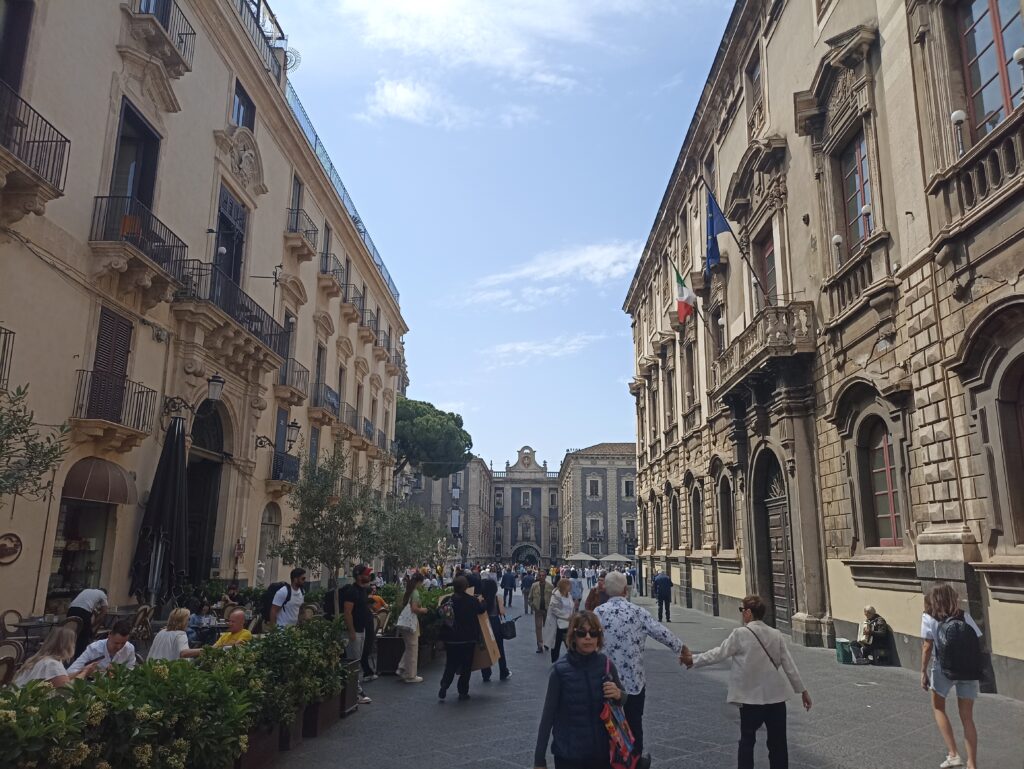
A questi elementi di debolezza Catania ne aggiunge purtroppo altri, ricollegabili sostanzialmente ad una mancanza di visione unitaria tale da guidarla all’interno della competizione fra destinazioni turistiche moderne. Gli effetti di tale mancanza di governance condivisa si concretizzano in una debolezza in termini di pianificazione strategica e di gestione della destinazione, tutti elementi che nel tempo hanno mortificato la capacità attrattiva e i benefici effetti moltiplicativi del turismo. Alcuni dati, seppur non aggiornati (l’Istat e l’osservatorio turistico regionale non hanno ancora rilasciato i dati del 2023) consentono di apprezzare pienamente il fenomeno. Negli ultimi 7 anni (dal 2016 al 2022) Catania non ha superato la soglia dei 475.000 arrivi (415.000 al 2022), se consideriamo l’ambito provinciale il dato non supera i 915.000 arrivi (817.000 al 2022). A livello regionale Catania è la terza città siciliana per arrivi internazionali e la seconda per quelli nazionali.
La permanenza media nella città di Catania al 2022 è di 2,2 notti per arrivo e tale dato non si discosta da quello rilevato negli ultimi anni. Lo stesso dicasi per il valore provinciale, seppur leggermente più alto (2,3). Per fare un confronto, la permanenza media nella provincia di Palermo al 2022 è di 2,9 notti per arrivo. Se osserviamo il dato regionale ci accorgiamo di quanto questo sia sensibilmente più alto (3 notti per arrivo). L’areale turistico di Catania, inteso come città o come provincia, mostra quindi una modalità di consumo turistico sensibilmente diversa da quella rilevata a livello regionale. Ulteriori elementi di riflessione in questo ambito sono suggeriti dall’analisi della permanenza rispetto alla tipologia ricettiva. Fra alberghiero ed extralberghiero sussiste un rapporto a sfavore del primo sia se consideriamo la città, sia se consideriamo l’area provinciale. Nuovamente, come per i precedenti dati analizzati, il confronto regionale mostra un dato differente, con una distanza, fra queste due modalità di accoglienza, sostanzialmente nulla.
Ancora su questo aspetto risulta utile l’utilizzo dell’indicatore sul turismo nei mesi non estivi (Istat), che rapporta le presenze di tale periodo (non si considerano giugno, luglio, agosto e settembre) rispetto alla popolazione residente. Ebbene tale valore risulta per la provincia di Catania pari a 0,9, prossimo, seppur inferiore, al valore regionale (1,1) e molto lontano da regioni star come il Lazio (3,5) e il Veneto (4,4).
Infine il tasso di turisticità che fornisce una misura dell’affollamento di una determinata area rispetto alle presenze turistiche dimostra la distanza del valore comunale e provinciale da quello regionale. Nel primo caso l’indicatore al 2022 è infatti pari a 2, per la provincia raggiunge il valore di 1,8. Per la Sicilia è pari a 3,1.
Per interpretare il quadro delineato, risulta molto utile l’analisi sulla stagionalità che mostra come evidentemente la città si sia trasformata in gate d’ingresso per il territorio. In 7 anni il picco stagionale di giugno e ottobre risulta assottigliato. Aumentano gli arrivi nei mesi spalla (aprile e maggio). Sono cresciuti i flussi nei mesi di luglio e agosto. Questo ridimensionamento dei picchi stagionali, unitamente alla ridotta permanenza media, disegnano i tratti del mercato turistico come quelli di una città di passaggio o adatta a city breaks.
Unfortunately, to these elements of weakness Catania adds others, linked to a lack of unified vision capable of guiding it within the competition between modern tourist destinations. The effects of this lack of shared governance materialize in a weakness in terms of strategic planning and destination management, all elements which over time have affected the attractiveness and multiplicative economic effects of tourism. Some data, although not updated (Istat and the regional tourist observatory have not yet released the 2023 data) allow us to fully appreciate the phenomenon. In the last 7 years (from 2016 to 2022) Catania has not exceeded the threshold of 475,000 arrivals (415,000 by 2022), if we consider the provincial scope the figure does not exceed 915,000 arrivals (817,000 by 2022). At a regional level, Catania is the third Sicilian city for international arrivals and the second for national ones.
The average stay in the city of Catania in 2022 is 2.2 nights per arrival and this figure does not differ from that recorded in recent years. The same applies to the provincial value, albeit slightly higher (2.3). For comparison, the average stay in the province of Palermo in 2022 is 2.9 nights per arrival. If we look at the regional data, we realize how significantly higher this is (3 nights per arrival). The tourist area of Catania, understood as a city or as a province, therefore shows a different type of tourist consumption from that found at a regional level. Further elements for reflection in this area are suggested by the analysis of the duration of the holiday with respect to the type of accommodation. There is a relationship between hotels and non-hotels that is unfavourable to the former both if we consider the city and the provincial area. Once again, as with the previous data analysed, the regional comparison shows a different figure, with a distance between these two reception methods that is essentially zero.
Again, on this aspect, the use of the indicator on tourism in the non-summer months (Istat) is useful, which compares the presences of this period (June, July, August and September are not considered) compared to the resident population. This value for the province of Catania is equal to 0.9, close, albeit lower, to the regional value (1.1) and very far from star regions such as Lazio (3.5) and Veneto (4.4).
Finally, the tourist rate, which provides a measure of the crowding of a given area compared to tourist presences, demonstrates the distance between the municipal and provincial value and the regional one. In the first case the indicator in 2022 is in fact equal to 2, for the province it reaches the value of 1.8. For Sicily it is equal to 3.1.
To interpret the outlined picture, the analysis on seasonality is very useful, showing how the city has evidently transformed itself into an entry gate for the territory. In 7 years, the seasonal peak of June and October has diminished. Arrivals increase in the shoulder months (April and May). Flows increased in the months of July and August. This reduction in seasonal peaks, together with the reduced average length of stay, characterizes the tourist market as that of a transit city or one suitable for city breaks.
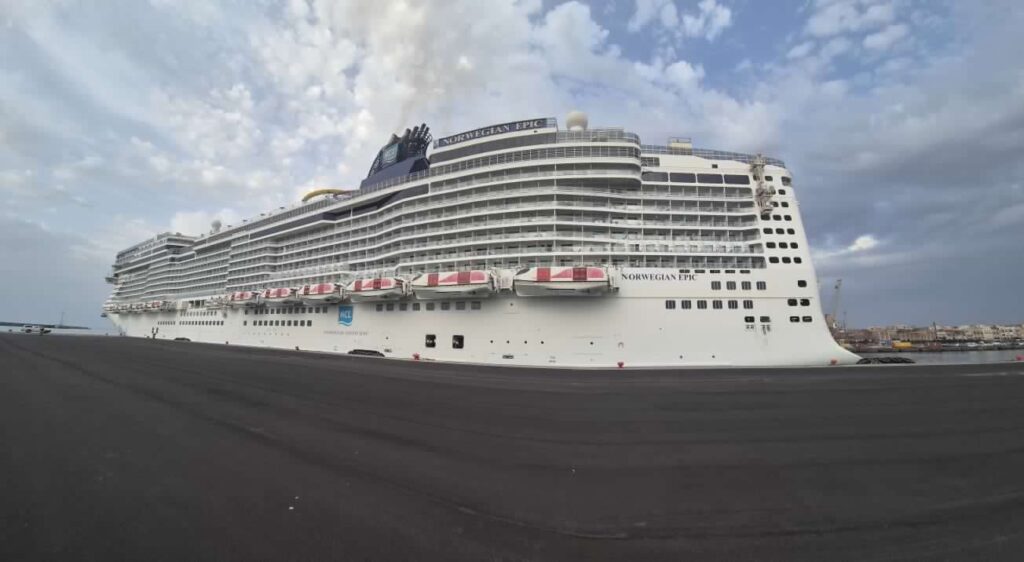
Nave da crociera attraccata nel porto di Catania. (Fotografia: Alessia Calì).
Cruise ship docked in the port of Catania. (Photo: Alessia Calì).
Indirizzi di policy
Policy Addresses
Il quadro delineato comporta una serie di conseguenze come ad esempio, l’effetto economico sul territorio, evidentemente ridimensionato rispetto alle reali potenzialità, e molto localizzato, in prossimità del centro storico, con la presenza di fenomeni di congestione che limitano nel tempo gli effetti positivi della spesa pro capite sul valore aggiunto.
A ciò si aggiunga il rischio di banalizzazione degli attrattori turistici, tipico in contesti dove il soggiorno è breve. Tutto questo ovviamente deprime la potenzialità turistica della città di Catania e suggerisce l’adozione di policy che possano ridare slancio al mercato turistico locale che anziché essere ancillare agli attrattori turistici di Taormina e di Siracusa e del sud-Est siciliano, diventi invece, al contrario, in una posizione più indipendente. Questo cambio di rotta dipende molto anche dalla da un diverso uso degli attrattori del mare organizzati in modo più sistemico a favore di forme di turismo sostenibile in modo da soddisfare le esigenze economiche locali, preservando l’integrità culturale e la diversità biologica.
The framework outlined produces a series of consequences such as, for example, the economic effect on the territory, scaled down compared to the real potential, and very localised, near the historic centre, with the presence of congestion phenomena which limit the positive effects of the per capita spending on value added.
Added to this is the risk of trivializing tourist attractions, typical in contexts where the stay is short. All this obviously reduces the tourist potential of the city of Catania and suggests the adoption of policies that can give new impetus to the local tourist market which, instead of being ancillary to the tourist attractions of Taormina and Syracuse and south-eastern Sicily, becomes instead, on the contrary, in a more independent position. This change of direction also depends greatly on a different use of the Sea’s attractors organized in a more systemic way in favour of forms of sustainable tourism in order to satisfy local economic needs, preserving cultural integrity and biological diversity.
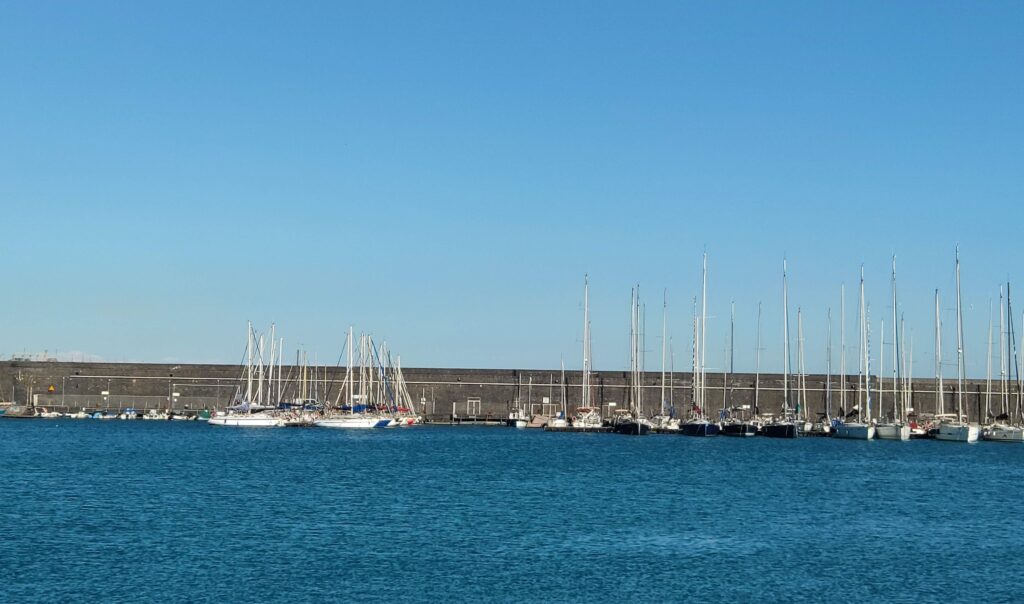
Imbarcazioni attraccate lungo la diga foranea nel Porto di Catania. (Fotografia: Elena Cocuzza).
Boats docked along the breakwater in the Port of Catania. (Photo: Elena Cocuzza).
IMMAGINE INIZIALE | Terminal crociera nel porto di Catania. (Foto: Elena Cocuzza).
HEAD IMAGE | Terminal cruise in the Port of Catania. (Photo: Elena Cocuzza).
╝
RIFERIMENTI
REFERENCES
Banca d’Italia (2019), Turismo in Italia: numeri e potenziale di sviluppo, Questioni di Economia e Finanza (Occasional Papers) n. 505.
SVIMEZ (2023), Rapporto SVIMEZ 2023. L’economia e la società del mezzogiorno, Il Mulino.
Di Bella, S. (2011). “Il waterfront di Catania: tra tradizione e modernità”. Geotema, vol. 40. pp. 94-102.